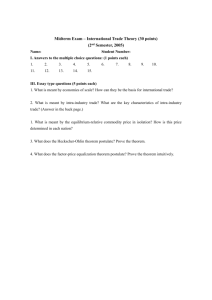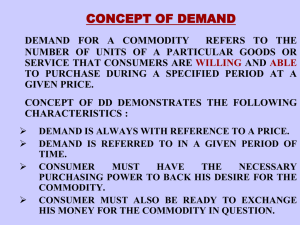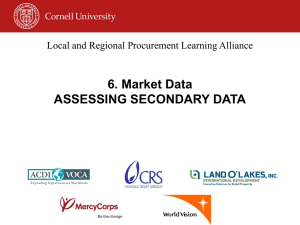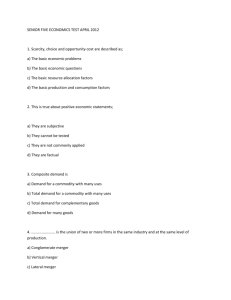Mid_2007
advertisement
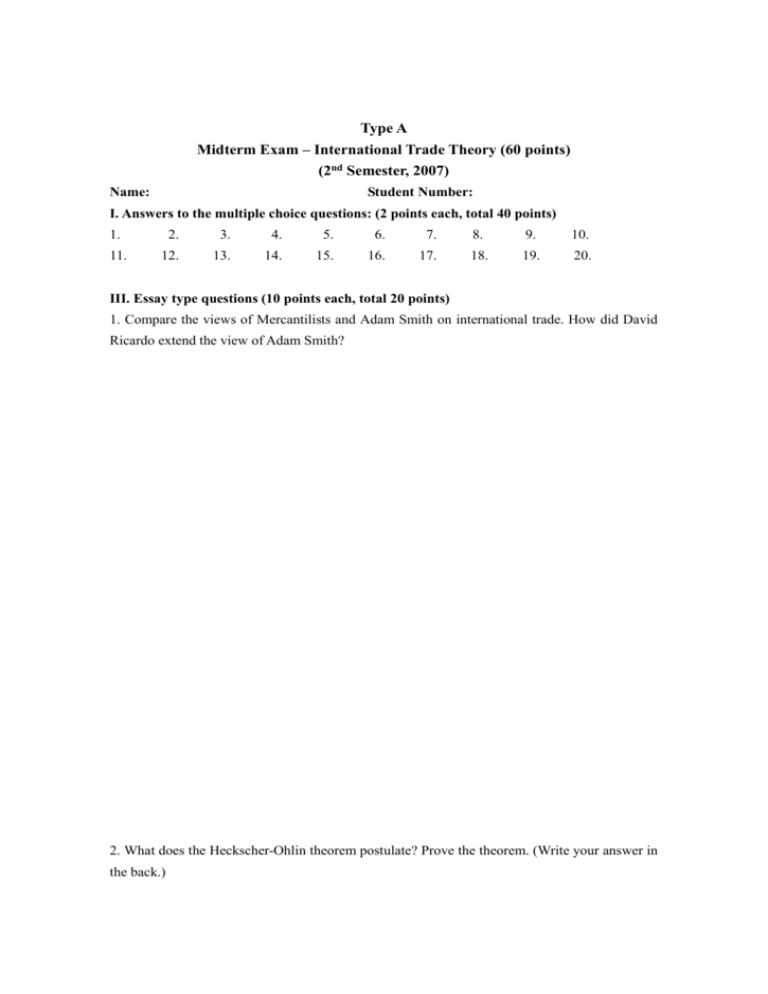
Type A Midterm Exam – International Trade Theory (60 points) (2nd Semester, 2007) Name: Student Number: I. Answers to the multiple choice questions: (2 points each, total 40 points) 1. 2. 3. 4. 5. 6. 7. 8. 9. 10. 11. 12. 13. 14. 15. 16. 17. 18. 19. 20. III. Essay type questions (10 points each, total 20 points) 1. Compare the views of Mercantilists and Adam Smith on international trade. How did David Ricardo extend the view of Adam Smith? 2. What does the Heckscher-Ohlin theorem postulate? Prove the theorem. (Write your answer in the back.) I. Multiple choice questions (2 points each) – Type A 1. International economics deals with: a. the flow of goods and services among nations b. the flow of capital among nations c. policies directed at regulating the flow of goods, services and payments d. the effects of trade policies on the welfare of the nation e. all of the above 2. International trade is similar to interregional trade in that both must overcome: a. distance and space b. trade restrictions c. differences in currencies d. differences in monetary systems e. none of the above 3. The opening or expansion of international trade usually affects: a. all members of society positively b. all members of society negatively c. most members of society positively but some negatively d. most members of society negatively but some positively e. half members of society positively but half negatively 4. The commodity in which the nation has the smaller absolute disadvantage is the commodity of its: a. absolute disadvantage b. absolute advantage c. comparative disadvantage d. comparative advantage e. None of above 5. In the Recardian model, if with one hour of labor time nation 1 can produce either 5X or 1Y while nation 2 can produce either 5X or 5Y (and labor is the only input): a. Nation 1 has a comparative advantage in commodity X b. Y is relatively cheaper in Nation 1 than in Nation 2. c. Nation 2 has a comparative advantage in commodity X or Y d. Nation 1 has a comparative advantage in neither commodity e. None of the above 6. If Py/Px is smaller in nation 1 than in nation 2 without trade: a. Nation 1 has a comparative advantage in commodity X b. Nation 2 has a comparative advantage in commodity Y c. Nation 1 has a comparative disadvantage in commodity X d. Nation 1 has a comparative advantage in neither commodity e. None of the above 7. Mutually beneficial trade can occur if production frontiers are: a. different but tastes are the same b. different and tastes are also different c. the same and tastes are also same d. all of the above e. none of the above 2 8. If a nation’s average price of exporting goods decreases in a two-nation world: a. the nation’s terms of trade improve b. the trading partner’s terms of trade deteriorate c. the nation’s terms of trade deteriorate and the trading partner’s terms of trade improve d. any of the above e. none of the above 9. Which of the following statements about community indifference curves is not true? a. They show the various combinations of two commodities that yield equal satisfaction to the nation. b. They are negatively sloped c. They are convex to the origin d. They are related to individuals’ indifference curves e. They never intersect each other 10. Which of the following is the right statement? a. Commodity X is labor intensive with respect to Y when more labor is used in the production of X than Y b. Commodity X is labor intensive with respect to Y when a larger K/L ratio is required in the production of X than in the production of Y c. Nation 1 is abundant in K if it has a greater absolute amount of K than Nation 2. d. Nation 1 is abundant in K if it has a higher K/L than Nation 2. e. Nation 1 is abundant in K if it has a higher r/w than Nation 2. 11. According to the H-O model, international trade will: a. reduce international differences in relative factor prices, but not in absolute prices b. reduce international differences in absolute factor prices, but not in relative prices c. reduce international differences in relative and absolute factor prices d. increase international differences in relative and absolute factor prices e. increase international differences in absolute but not relative commodity prices 12. The Leontief paradox refers to the empirical finding that U.S. a. imports substitutes are more labor intensive than exports b. imports are more labor intensive than exports c. exports are more capital intensive than imports d. exports are more labor intensive than import substitutes e. none of the above 13. A difference in relative commodity prices between nations can not be based on a difference in: a. technology b. factor endowments c. tastes d. economies of scale e. none of the above 14. International trade can be based on economies of scale even if both nations have identical: a. factor endowments b. tastes c. technology d. all of the above e. none of the above 3 15. Which of following is not a proper explanation about intra-Industry trade: a. It takes place because products are homogeneous. b. It takes place in order to take advantage of economies of scale c. It takes place because monopolistic competition is the prevalent form of market organization d. It arises more between nations with similar tastes and income levels. e. While most of the trade between developed and developing countries is inter-industry trade, an increasing proportion of the trade among industrial countries is intra-industry trade. 16. If a nation’s exports and imports of a differentiated product are equal, Grubel-Lloyd’s Intraindustry (T) index of the nation is equal to: a. 1.00 b. 0.75 c. 0.50 d. 0.25 e. 0.00 17. If the nation’s tastes for its import commodity decrease: a. the nation’s offer curve rotates toward the axis measuring its import commodity b. the partner’s offer curve rotates toward the axis measuring its import commodity c. the partner’s offer curve rotates toward the axis measuring its export commodity d. the nation’s offer curve rotates toward the axis measuring its export commodity e. the nation’s terms of trade deteriorate 18. The H-O model extends the classical trade model by: a. explaining the basis for comparative advantage b. examining the effect of trade on factor prices c. examining the effect of change in technology d. Both a and b e. Both a and c 19. Which is not an assumption of the H-O model? a. The same technology in both nations b. Constant returns to scale c. Complete specialization d. Equal tastes in both nations e. One country is a capital abundant country and the other country is a labor abundant country. 20. The theory that a nation exports those products for which a large domestic market exists was advanced by: a. Herberler b. Linder c. Heckscher and Ohlin d. Leotief e. Ricardo 4
